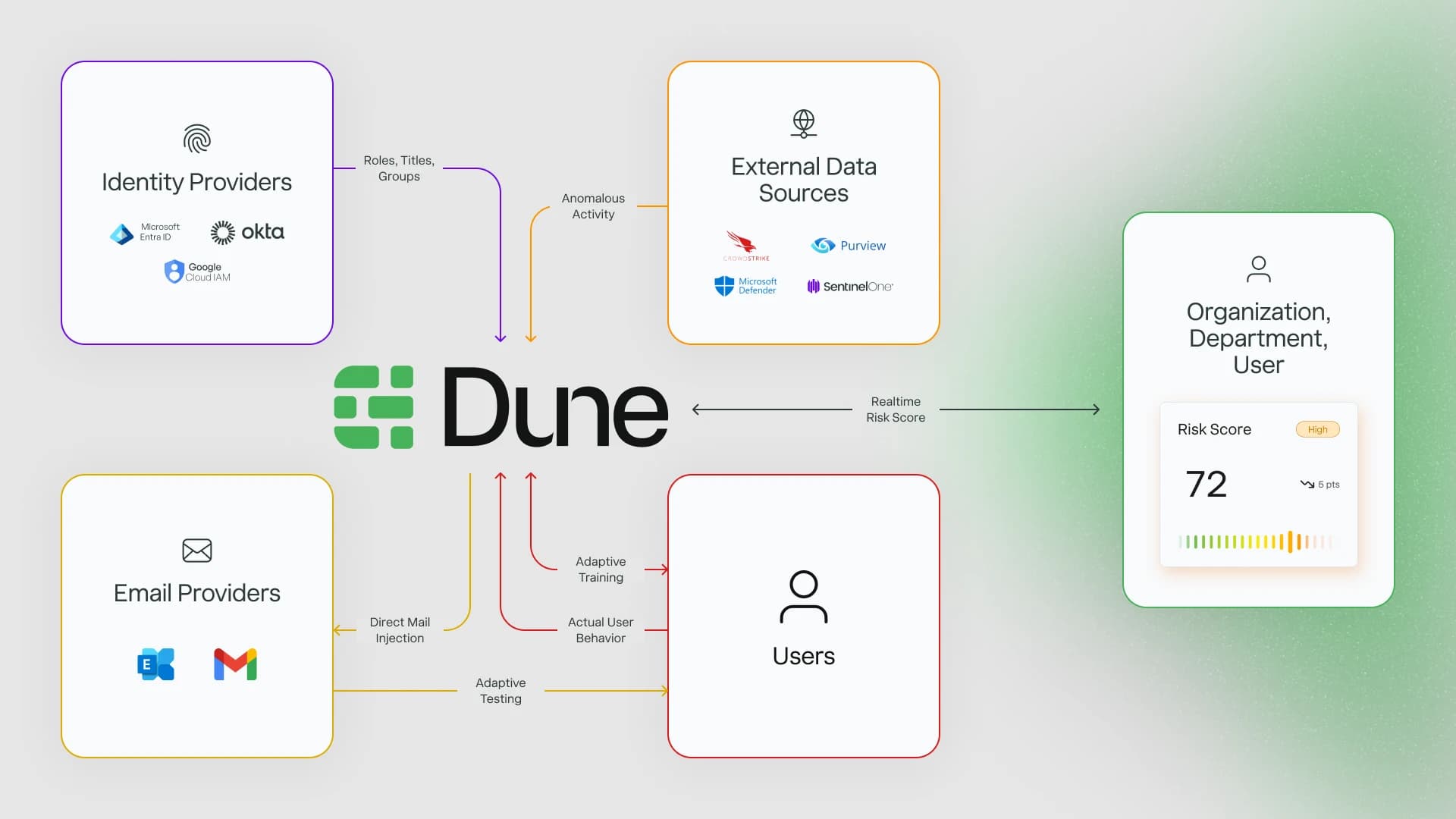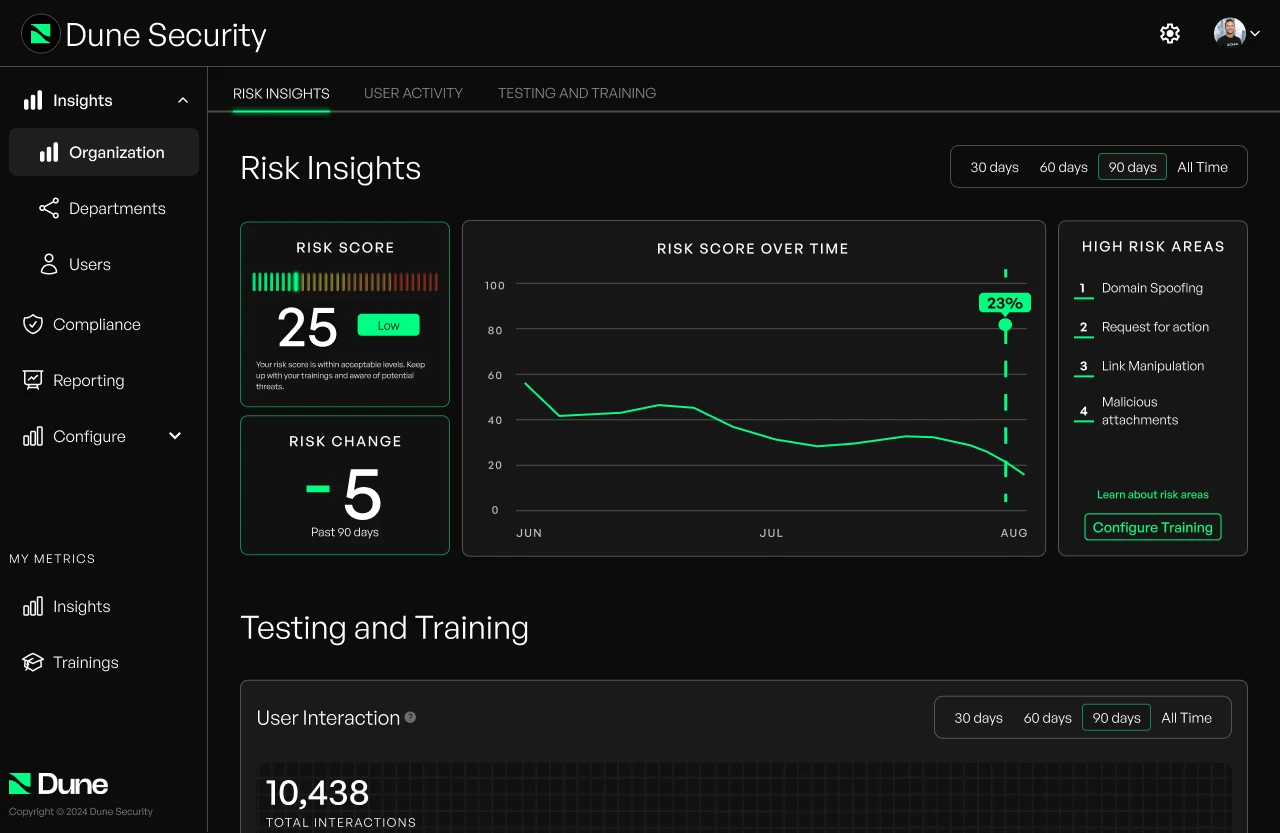Dune Security
Redefining User Adaptive Risk Management

Summary
As the sole product designer, I led a ground-up redesign of Dune Security’s platform—transforming fragmented, complex security data into actionable, user-centric workflows. My work not only improved the product experience but also drove strategic shifts in how the company positioned, sold, and scaled the platform.
The Challenge
Security awareness training was failing to keep pace with AI-powered threats. CISOs and security teams were overwhelmed by fragmented data (IAM, EDR, DLP, SEG) and lacked actionable insights to reduce human-driven cyber risk. Existing tools felt like static report cards, not dynamic control centers for prevention and action.
“I can’t tell which users are putting us most at risk.” – Fortune 500 CISO

Hypotheses & Success Metrics
- Real-time, actionable risk insights (vs. compliance checklists) will increase CISO engagement and drive faster risk mitigation.
- Adaptive, automated training will raise employee completion rates and reduce manual workload for security teams.
- A unified design system will speed up development and improve platform consistency.
Employee training completion rates
Dashboard-related support tickets
Expansion to new enterprise clients
Faster time-to-production for new features
Business & Product Strategy
I co-created the product roadmap with the CEO and CTO, using a RICE scoring model to prioritize features that balanced user impact and engineering effort. For example, we launched the adaptive training module before advanced analytics, as user interviews revealed immediate pain around manual interventions. This accelerated customer value and improved our sales narrative.
I also worked closely with the GTM team, translating user research into sales enablement materials and product messaging. The new risk score visualization became a core part of our sales pitch, helping the GTM team clearly articulate ROI to prospects and close deals more effectively.
User Research & Insights
- CISO Committee: Tapped 50+ CISOs for feedback—highlighting the need for real-time, actionable insights.
- Customer Success Feedback: Weekly check-ins surfaced core pain points and usability issues.
- Competitive Analysis: Benchmarked KnowBe4, Hoxhunt, Proofpoint PSAT, and others for opportunities in clarity, speed, and differentiation.
“The dashboard feels like a report card, not a control center.”
Design Process
Making Data Actionable
- Collaborated with backend engineers to distill raw risk data into 12 key signals (e.g., repeated phishing failures, low training engagement).
- Designed a unified risk score and visualization for instant identification of riskiest users/departments, with drill-downs for root cause analysis.
- Built adaptive workflows to auto-assign targeted training, reducing manual intervention.
Building for Scale & Usability: The Stillsuit Design System
- Developed the “Stillsuit” design system to standardize UI components and documentation, reducing onboarding time for new engineers by 50%.
- Supported both CISO dashboards (org-wide risk, benchmarking) and employee views (personal risk, training progress), with accessibility for an older workforce.

Iteration & Feedback Loops
- Instituted a two-week design-to-production cycle for rapid iteration.
- Incorporated customer feedback quickly, e.g., adding a “Trending Threats” widget after multiple CISO requests.
Key Decisions & Pivots
- Shifted from static reporting to dynamic, actionable dashboards based on CISO committee feedback.
- Prioritized adaptive training workflows to address low engagement and high manual workload.
- Invested in a robust design system early to enable rapid scaling and consistent experience.
Org-Level Impact
My design work led to a strategic shift in how Dune Security viewed and communicated user risk. The new risk score visualization fundamentally changed how the GTM team positioned the product, making user risk transparent and actionable. This clarity enabled sales to articulate value more effectively, directly influencing both sales messaging and future roadmap priorities.


Outcomes & Impact
- 32% increase in employee training completion
- 90% drop in dashboard-related support tickets
- Expanded to 15+ Fortune 500 clients; platform cited as a “must-have” by security leaders
- Designed investor decks and sales materials that helped close a $6M seed round

Reflection & Learnings
Working as the sole designer was a masterclass in ownership, prioritization, and cross-functional leadership. Building the design system and rapid feedback loops enabled us to scale quickly and deliver real value. With more resources, I would have invested further in micro-interactions and visual polish—but focusing on speed and user impact was critical in our startup phase.